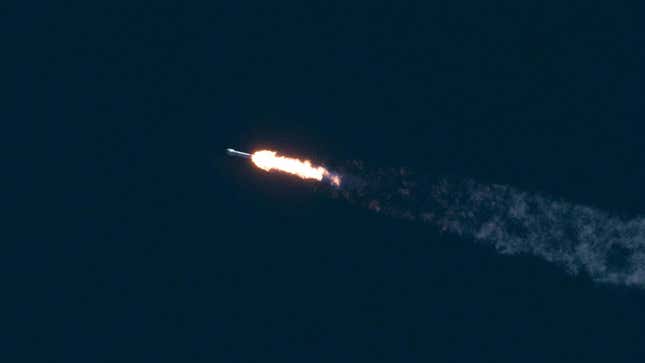
Update 2/14/2022: New analysis suggests the object that will hit the Moon is actually a Chinese booster, not a Falcon 9 second stage. Original article appears below.
A Falcon 9 second stage has been tumbling uncontrollably in space since 2015, but experts say its seven-year journey is coming to an end, as the 4-ton rocket part is expected to hit the Moon in a matter of weeks.
The spent rocket stage is expected to hit somewhere near the lunar equator on March 4, according to Bill Gray, creator of Project Pluto, a software program for tracking near-Earth objects, asteroids, comets, minor planets, and other things floating in space. There is still some uncertainty about the exact timing and location of the collision, but the current data shows a “certain impact,” writes Gray.
The out-of-control second stage poses no threat to life or equipment and at most will produce a new lunar impact crater. The impact is not likely to be visible from Earth.
“For those asking: yes, an old Falcon 9 second stage left in high orbit in 2015 is going to hit the moon on March 4. It’s interesting, but not a big deal,” tweeted Jonathan McDowell, an astronomer from the Harvard-Smithsonian Center for Astrophysics. He added that “things left in cislunar orbit [orbits between the Earth and Moon] are unstable—will eventually either hit the Moon or the Earth or get perturbed to solar orbit.”
This particular Falcon 9 rocket launched from Cape Canaveral in Florida on February 11, 2015. The launch was notable for two reasons: It was the first SpaceX launch of a U.S. research satellite and the private company’s first launch to interplanetary space. The mission saw the successful delivery of NOAA’s Deep Space Climate Observatory, or DSCOVR, which monitors solar winds in real time from L1, the first Lagrange point between Earth and the Sun.
DSCOVR nestled into its neutral gravitational spot some 932,000 miles (1.5 million km) from Earth, but the Falcon 9 booster stayed behind. As Ars Technica reports, the “second stage was high enough that it did not have enough fuel to return to Earth’s atmosphere” and it “lacked the energy to escape the gravity of the Earth-Moon system, so it has been following a somewhat chaotic orbit” since entering into space in 2015.

The rocket stage is tumbling, rotating about once every 180.7 seconds, or possibly once every 90.4 seconds, according to Gray’s data. More observations are needed to confirm the booster’s movements, as the Yarkovsky effect could come into play, in which incoming sunlight slightly influences an object’s drift rate and thus its projected time of impact.
Gray wrote on Project Pluto’s website that the booster will strike the lunar surface at speeds reaching 1.6 miles per second (2.58 km/s), but he suspects that “the impact itself will have to go unobserved” as “the bulk of the moon is in the way, and even if it were on the near side, the impact occurs a couple of days after New Moon.”
Interestingly, this will mark the first time, at least as far as I’m aware, that a piece of space junk will unintentionally reach the Moon. Our stuff has accidentally crashed onto the surface during botched landing attempts, recent examples being the failed landing of India’s Vikram probe and Israel’s Beresheet probe, both in 2019. And in 2009, NASA intentionally crashed a Centaur upper stage onto the Moon as part of the Lunar Crater Observation and Sensing Satellite (LCROSS) mission.
More: New Image Shows Webb Space Telescope Parked in its Final Orbit.